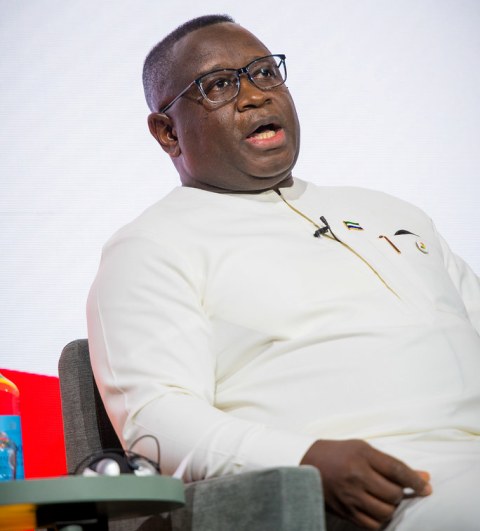President Bio Commissions Mattru-Senehun Bridge to Boost Rural Connectivity
Spanning 160 metres across the Jong River, the new bridge replaces a colonial-era manual ferry system that had, for decades, hindered mobility and posed serious safety risks.

- Country:
- Sierra Leone
In a historic moment for rural development and infrastructure advancement in Sierra Leone, His Excellency President Dr Julius Maada Bio officially commissioned the newly constructed Mattru Jong–Senehun Bridge in Jong Chiefdom, Bonthe District. This transformative bridge project is expected to drastically improve connectivity for more than 20,000 residents, eliminating long-standing transportation barriers and fostering economic and social development across the region.
Spanning 160 metres across the Jong River, the new bridge replaces a colonial-era manual ferry system that had, for decades, hindered mobility and posed serious safety risks. The bridge connects Mattru Jong, considered the mainland gateway to Bonthe District, to surrounding regions, including Bo, Moyamba, and Pujehun Districts—thereby opening vital access to markets, schools, and healthcare facilities.
A Vision Realized: Fulfilling a Presidential Promise
During his keynote address, President Bio described the bridge’s commissioning as both a deeply personal and national milestone, representing the government’s commitment to tangible transformation under his Big Five Game Changer agenda.
“This is a promise fulfilled to my people, to our district, and to our future,” the President stated. “Where others talked about development, we are delivering it. We are the Tok N Do government.”
He recounted the challenges residents faced using the outdated ferry system, which was operational only in daylight, prone to interruptions during the rainy season, and fraught with danger. “These were not just inconveniences,” he said, “they were barriers to education, healthcare, trade, and dignity.”
Powered by Partnerships: The Role of the World Bank
The Mattru-Senehun Bridge is one of four major bridges constructed under the Smallholder Commercialisation and Agribusiness Development Project (SCADeP), with funding from a US$30 million grant provided by the World Bank. The initiative is implemented under the auspices of the Ministry of Agriculture and Food Security and supervised by the Sierra Leone Roads Authority (SLRA).
Other bridges constructed through this initiative include:
-
Gendema Bridge – Kenema District
-
Manowa Bridge – Kailahun District
-
Tomparie Bridge – Karene District
President Bio expressed heartfelt appreciation to all stakeholders involved—paramount chiefs, Members of Parliament, local councils, and engineers—for their collaboration, while extending special gratitude to the World Bank for their “unwavering partnership in supporting real change.”
“You have walked this journey with us,” President Bio said, “but we are not done. There are more bridges to build, more communities to connect.”
A Bridge for the People: Empowering Communities
The bridge’s impact is far-reaching. According to the President, the structure will now ensure:
-
Faster and safer access to clinics for mothers and children
-
More reliable transportation for students
-
Efficient delivery of agricultural produce to regional and national markets
-
Lower travel costs and reduced travel time
Minister of Agriculture, Dr Henry Musa Kpaka, hailed the bridge as a “flagship success” of President Bio’s infrastructure drive. He emphasized that rural farmers, often at the mercy of unreliable transport, will now have the confidence to scale up production, invest in post-harvest storage, and benefit from higher market prices.
A Symbol of Progress and Potential
Speaking on behalf of the World Bank, Country Manager Dr Abdul Muwonge commended the government and people of Sierra Leone for their strong coordination and vision.
“This bridge is more than concrete and steel—it is a legacy that will serve generations,” Dr Muwonge stated.
He praised President Bio for effectively presenting Sierra Leone’s case to the World Bank, which has resulted in additional funding for upcoming infrastructure projects. He reaffirmed the Bank’s long-term commitment to supporting Sierra Leone’s inclusive development strategy.
From Manual Ferries to Modern Mobility
The Mattru Jong–Senehun route was previously one of 13 manual ferry points across Sierra Leone identified for replacement under the government’s rural modernization plan. These sites, remnants of colonial infrastructure, have long been considered unsafe and inefficient, especially during peak farming seasons or inclement weather.
Now, with the completion of this bridge, the region steps into a new era—one that emphasizes dignity, safety, and connectivity. President Bio reiterated that bridges like these are pathways to prosperity, creating the groundwork for an equitable society where every Sierra Leonean has the tools to thrive.
A National Blueprint: One Bridge at a Time
As the ceremony drew to a close, President Bio reminded citizens that this achievement is part of a larger national roadmap aimed at building resilient infrastructure, stimulating agricultural transformation, and deepening social inclusion.
“We are building more than bridges. We are building trust, opportunity, and a brighter future for every village, every family, and every generation.”
The successful commissioning of the Mattru-Senehun Bridge stands as a beacon of hope—a symbol of visionary leadership, international collaboration, and people-centered governance.










